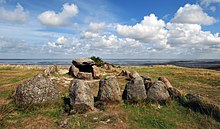
Back Megaliet Afrikaans Megalito AN جندل (آثار) Arabic Meqalit Azerbaijani Megalėtā BAT-SMG Мегаліты Byelorussian Мегалит Bulgarian মহাশ্ম Bengali/Bangla Megàlit Catalan Megalit Czech



A megalith is a large stone that has been used to construct a prehistoric structure or monument, either alone or together with other stones. There are over 35,000 in Europe alone, located widely from Sweden to the Mediterranean sea.[1]
The word was first used in 1849 by the British antiquarian Algernon Herbert in reference to Stonehenge[2][3] and derives from the Ancient Greek words "mega" for great and "lithos" for stone. Most extant megaliths were erected between the Neolithic period (although earlier Mesolithic examples are known) through the Chalcolithic period and into the Bronze Age.[4]
- ^ "Europe's Megalithic Monuments Originated in France and Spread by Sea Routes, New Study Suggests".
- ^ Herbert, A. Cyclops Christianus, or the supposed Antiquity of Stonehenge. London, J. Petheram, 1849.
- ^ "Europe's Mighty Megaliths Mark the Winter Solstice". National Geographic Society. 21 December 2017. Archived from the original on 2020-01-02.
- ^ Johnson (1908), p. 67.
© MMXXIII Rich X Search. We shall prevail. All rights reserved. Rich X Search